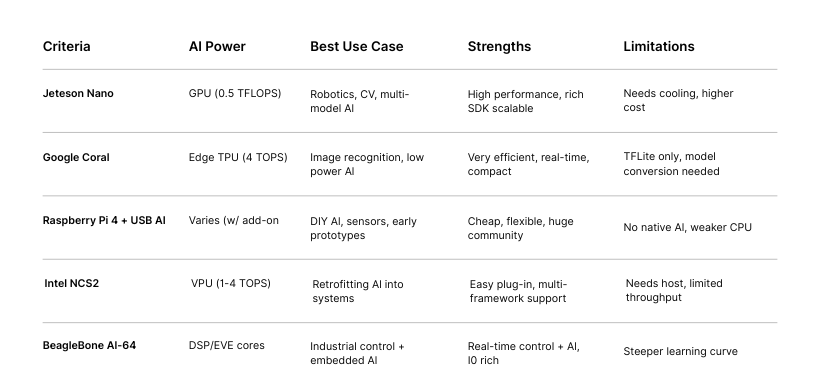Top 5 Edge AI Devices Like NVIDIA Jetson Nano (2025 Edition)
Top 5 Edge AI Devices Like NVIDIA Jetson Nano (2025 Edition)
Edge AI devices allow machine learning models to run directly on local hardware – enabling real-time decision-making without relying on constant cloud connectivity. Whether for computer vision, robotics, or smart sensors, choosing the right device is critical for performance, scalability, and success.
Here’s a ranked list of the top 5 most popular Edge AI devices, ideal for both prototyping and production.
1. NVIDIA Jetson Nano (and Jetson Family)
Popularity: 5/5
Best for: Vision-heavy AI, robotics, multi-camera systems
Why It Leads
NVIDIA Jetson Nano is the most widely adopted platform for edge AI developers. With a built-in GPU and full Linux support, it enables powerful real-time inferencing for use cases like robotics, smart retail, surveillance, and AI-enabled drones.
Pros
- High-performance GPU (CUDA-enabled)
- Excellent for deep learning with TensorFlow, PyTorch, etc.
- Rich ecosystem and active community
- Scales to Jetson Xavier NX and Orin for production-grade power
Cons
- Higher power consumption
- Requires cooling for sustained loads
- Pricier than ultra-low-cost alternatives
2. Google Coral Dev Board / USB Accelerator
Popularity: 4/5
Best for: Real-time image classification, IoT vision, low-power AI
Why It’s Popular
Google Coral devices run TensorFlow Lite models using a built-in Edge TPU — delivering excellent inferencing speeds with ultra-low power. Ideal for real-time vision tasks in energy-constrained environments.
Pros
- Blazing fast for 8-bit quantized models
- Compact and power-efficient (USB version available)
- Smooth TensorFlow Lite integration
- Great for vision AI at the edge
Cons
- Limited to supported models/layers
- Only supports TensorFlow Lite
- Smaller community than Jetson
3. Raspberry Pi 4 + AI Accelerators (e.g., Coral USB, Intel NCS2)
Popularity: 4/5
Best for: DIY AI, smart sensors, small-scale prototypes
Why It’s a Go-To Platform
The Raspberry Pi 4 is a general-purpose single-board computer with a huge ecosystem. While not AI-native, it’s often combined with USB accelerators to add neural inference capability — ideal for simple computer vision, voice commands, and IoT logic.
Pros
- Very low cost and widely available
- Massive developer and maker community
- Flexible and modular (can be enhanced with Coral or NCS2)
- Good for early-stage prototyping
Cons
- No built-in neural accelerator
- Limited performance without add-ons
- Can overheat under load without cooling
4. Intel Neural Compute Stick 2 (NCS2)
Popularity: 4/5
Best for: Plug-and-play AI acceleration, retrofitting edge intelligence
Why Developers Love It
The Intel NCS2 is a USB-based AI accelerator powered by the Myriad X VPU. It’s great for boosting vision AI tasks on devices like Raspberry Pi or small form-factor PCs, without needing built-in AI hardware.
Pros
- Easy to use with existing devices
- Supports many frameworks via OpenVINO
- Scalable: use multiple sticks for heavier workloads
- Low power, portable
Cons
- Requires a host device (not standalone)
- Mid-range performance
- Some learning curve with OpenVINO
5. BeagleBone AI-64
Popularity: 3/5
Best for: Real-time control + edge AI in industrial settings
Why It’s Unique
BeagleBone AI combines embedded AI cores (DSP + EVE) with real-time microcontrollers, making it a great fit for robotics and industrial automation where timing and AI need to coexist. Ideal for developers seeking low-level control and integrated hardware.
Pros
- Built-in real-time processors (PRUs)
- AI co-processors for efficient inferencing
- Robust I/O for sensors and actuators
- Open-source hardware platform
Cons
- Complex software stack (requires TIDL/OpenCL)
- Not as powerful as Jetson for heavy models
- Smaller community and limited plug-and-play support
Summary Comparison

Final Thoughts
If you’re building a computer vision-heavy AI product, Jetson Nano or Xavier NX offers the best performance and flexibility. For low-power, image classification, Google Coral is unbeatable. If you’re budget-conscious or prototyping, Raspberry Pi with an AI stick is a great starting point. Intel NCS2 is a solid AI add-on, while BeagleBone AI is perfect for real-time robotics and industrial automation.
Need Help Choosing or Deploying an Edge AI Device?
At GenAI Protos, we build and optimize end-to-end Edge AI solutions for retail, healthcare, manufacturing, and smart devices — from prototyping to production, on platforms like Jetson, Coral, Raspberry Pi, and more.